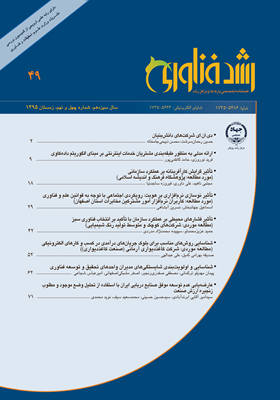دی.ان.ای شرکت های دانش بنیان
محورهای موضوعی :حسين رحمان سرشت 1 , محسن ذبيحي جامخانه 2
1 - دانشگاه علامه طباطبایی تهران
2 - پردیس فارابی دانشگاه تهران
کلید واژه: DNA سازمانی شرکت دانش بنیان پارک علم و فناوری دی.ان.ای سازمانی استعاره سازمانی,
چکیده مقاله :
امروزه فضای کسب و کار سازمان ها و شرکت ها بشدت تحت تاثیر اقتصاد دانش بنیان قرار دارد، بطوریکه ظهور شرکت هایی عنوان شرکت های دانش بنیان به امری عادی تبدیل شده است. شرکت هایی که با محوریت دانش و با تکیه بر نوآوری فناورانه و تجاری سازی آن شکل می گیرد و تولید ثروت و کارآفرینی هدف اصلی آنها است. بدون شک این شرکت ها با توجه به تفاوت با دیگر انواع سازمان ها، مشکلات و نارسایی های سازمانی خاص خود را دارند. استفاده از استعاره ها می تواند به مدیران در شناخت بهتر سازمان ها کمک کند و زوایای پنهان سازمان را برای حل بهتر مشکلات پیش روی آنان نمایان سازد. یکی از استعاره های جدید، دی.ان.ای سازمانی است که فرض آن این است که سازمان ساختاری شبیه به بدن موجود زنده دارد. براین اساس، در این پژوهش دی.ان.ای شرکت های دانش بنیان مطالعه شده است. جامعه آماری، شرکت های دانش بنیان مستقر در پارک علم و فناوری دانشگاه تهران (60 شرکت) است که از این میان، 10 شرکت (شامل 102 نفر) مورد مطالعه قرار گرفته است. ابزار گردآوری اطلاعات نیز پرسشنامه استاندار هونالد است. برای تحلیل داده ها از روش تحلیل واریانس و آزمون مقایسه های زوجی استفاده شده است. یافته های این پژوهش نشان می دهد دی.ان.ای شرکت های دانش بنیان مستقر در پارک علم و فناوری دانشگاه تهران به هیچ یک از چهار نوع دی.ان.ای ای که هونالد معرفی کرده است شباهت ندارد، و هریک از ابعاد مورد مطالعه، در یکی از انواع دی.ان.ای ها قرار می گیرد.
Today's, business environment arestrongly influenced by theknowledge basedeconomy and the emergence of knowledge-intensive firms is common. The firms that focus on knowledge, technological innovation and its commercialization, and their main purpose is wealth creation and entrepreneurship. No doubt these firms due to differences with other types of organizations, have their own problems and organizational gaps. Us of metaphors can help managers better understand the organization and reveals hidden aspects of it. Organizational DNA is a new metaphor which assumes that theorganization has a structure similar to a living organism. In this study knowledge-intensive firms in Tehran University Science and Technology Park (N=10, consisted of 102 employees) have been investigated. Research instrument was honold and silverman standard questionnaire and to analyze data, the analysis of variance and paired comparison test is used. The questionnaire consists of four dimensions: Leadership tasks and activities (includingmission, organizational structure and leadership style), management activities (including planning, team work and performance management), human resource performance (including employment, pay and training and staff development) organization daily activities (including decision-making, interpersonal relationships, processes of change and look to profit. The results indicated that the DNA of knowledge-intensivefirms in Tehran University Science and Technology Park is not similar to any of four types of DNA (Factual, Conceptual, Contextualized and Individual DNA) that Honold and silverman introduced, and Each of the dimensions is scattered in each of four types of DNA.
1- الوانی، سیدمهدی، مدیریت عمومی، نشر نی، تهران، 1392.
2- طبرسا، غلامعلی و نظریپور، امیرهوشنگ، بررسی عوامل مؤثر بر ارتقای هوشمندی انسانی- ساختاری در سازمانهای دانشبنیان، پژوهشهای مدیریت در ایران، دوره 17، شماره 1، صص 11-131، 1392.
3- رمضان، مجید و حسنوی، رضا، بهرهوری دانش در سازمانهای دانشی، آتینگر، تهران، 1393.
4- ذبیحی جامخانه، محسن، طراحی مدل دانشبنیان شدن مرکز مطالعات قرارگاه پدافند هوایی خاتم (ص) آجا، تهران: انتشارات قرارگاه پدافند هوایی خاتم، 1395.
5- حاجی کریمی، عباسعلی، بطحایی، عطیه، مدیریت سرمایههای فکری (مزیت راهبردی ارزشآفرینی سازمانی) مفاهیم کاربردها، شرکت چاپ و نشر بازرگانی، تهران، 1388.
6- رحمانسرشت، حسین، تئوریهای سازمان و مدیریت از تجددگرایی تا پساتجددگرایی، دوران، تهران، 1393.
7- الهیاریفرد، نجف و عباسی، رسول، بررسی الگوی مناسب ساختار سازمانی شرکتهای دانشبنیان، فصلنامه تخصصی پارکها و مراکز رشد، سال 8، شماره 29، 1390.
8- Boulding, Kenneth, E., General system theory: the skeleton of scince.Management Science,Vol 2, No 3, 1956.
9- Morgan, G., Image of organization. Berret Coehler and Sage Publication, 1998.
10- Honold, L.; & Silverman, R., Organizational DNA and diagnosis of your organization for increased effectiveness. Isfahan: Shahid Hossein Fahmideh, 2011.
11- Booz,A., H., Organizational DNA, Booz & company. Retrieved from www.booz.com, 2004.
12- Martina, K., Urbancova, H.; Fejfar, J., Identification of Managerial Competencies in Knowledge-based Organizations. Journal of Competitiveness. Vol 4. No: 1, 2012.
13- Narasimha, S., Organisational Knowledge, Human Resource Management and Sustained Competitive Advantage: Toward a Framework,Competitiveness Review, Vol. 10 No. 1, 2000.
14- Vincenzo Cavaliere, Sara Lombardi and Luca Giustiniano, Knowledge Sharing in Knowledge-Intensive Manufacturing Firms. an Empirical Study of its Enablers, Journal of Knowledge Management Vol. 19 No. 6, pp. 1124-1145, 2015.
15- Claudio Dell’era, Paololandoni and Roberto Veganti (2015), From Creative Individuals to Creative Capital: Value Creation and Appropriation Strategies of Creative Knowledge-Intensive Business Services, International Journal of Innovation Management Vol. 19, No. 2, 2015.


